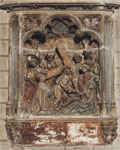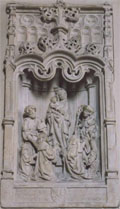Criteria for inclusion
Because the inventory formed part of a doctoral thesis its parameters were dictated by the scope of that thesis.
Consequently, the definitions of what constitutes a 'memorial' for the purposes of the inventory are rather narrower
than those employed elsewhere in the MeMO project.
The thesis was primarily concerned with those memorials which were installed on walls or piers above graves to
commemorate the deceased interred below and to elicit prayers for their souls. Often called 'epitaphs', they took
the form of sculpted stone tablets, panel paintings or engraved brass plates and would have been a common sight in
the churches and cloisters of the Low Countries. They include inscriptions naming the deceased and recording their
dates of death, typically accompanied by imagery showing the deceased kneeling in prayer together with their patron
saints before some holy personage.
Since the thesis focused on the wall-mounted memorial as a category of funerary monument, only those memorials which
had a definite, unambiguous relationship to a nearby grave are included in the inventory. However, tombs themselves,
along with grave slabs and other monuments that housed or covered bodily remains, are excluded from the inventory.
Other potentially commemorative artworks, including altarpieces, plate, textiles, and stained glass, are also
excluded from the inventory. Memorials that commemorate pious or charitable foundations are only inventoried if they
include a significant degree of imagery and were displayed in proximity to a grave.
In addition, please note the following:
- Only extant memorials (or lost memorials known from photographs or rubbings), are included in the inventory.
- Severely damaged and fragmentary memorials are only included where a significant degree of their imagery and / or
inscription remains.
|


|
Disclaimer:
2012: web design by Charlotte Dikken (UU). This website was tested and works on Internet Explorer, Opera and Firefox
and is best viewed on a fully maximized screen. Some of the features on this site use JavaScript.

Last updated on: 11 September, 2012.
|
|
|